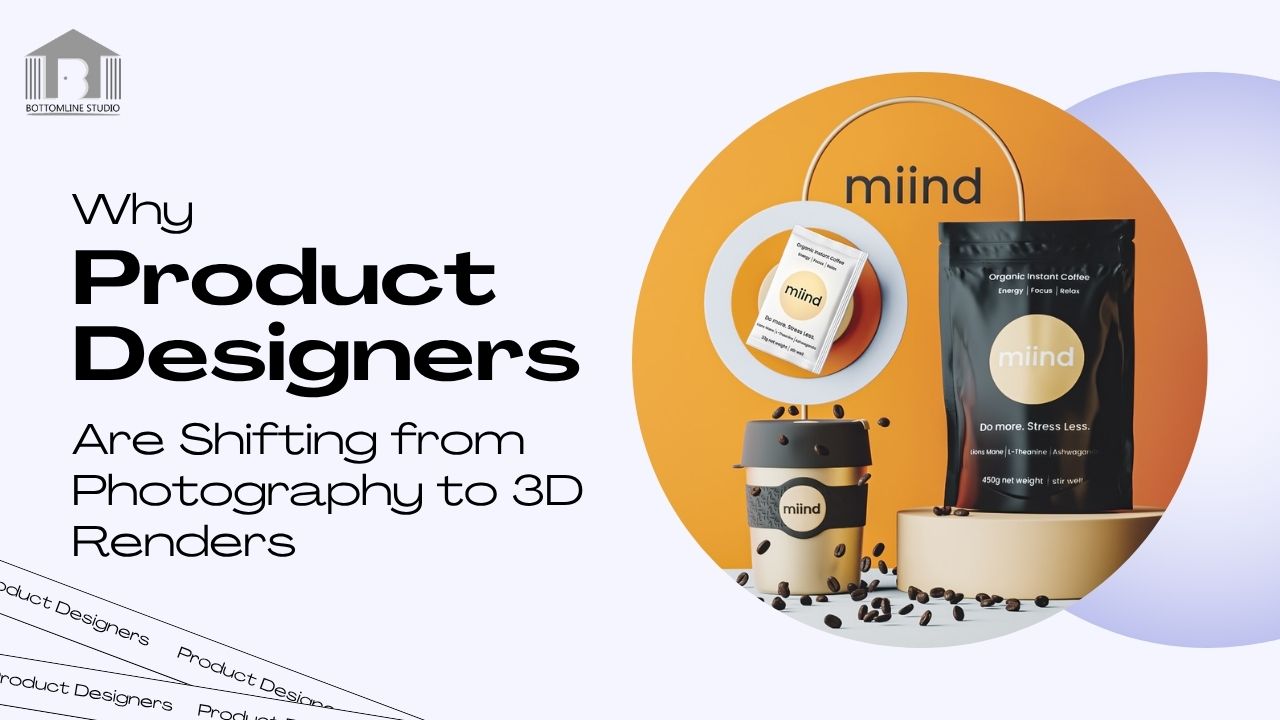In the fast-changing world of product design, visuals play a powerful role in capturing customer attention and driving conversions. For decades, photography was the go-to method for showcasing products in catalogs, websites, and advertisements. But now, a new wave is taking over 3D Renders for Product Design. From startups to global brands, designers are choosing 3D visuals over traditional photos.
But what’s driving this major shift? In this blog, we explore why product designers are moving away from photography and embracing the future of visual storytelling through 3D rendering.
The Limitations of Traditional Product Photography
Product photography has always been important for showing how a product looks, feels, and fits into daily life. However, the process comes with a set of challenges:
- High production costs for studio setup, lighting, props, and models.
- Limited flexibility once a product is shot, making edits often requires a full reshoot.
- Logistics of physically preparing the product and capturing it from every angle.
- Long lead times between product completion and launch-ready visuals.
These limitations can slow down the design-to-market timeline and stretch creative teams thin, especially when multiple versions, colors, or angles are required.
The Rise of 3D Renders in Product Design
So, what changed? The answer lies in the power of 3D Rendering Technology. With the help of software like Blender, 3ds Max, or KeyShot, product designers can now create hyper-realistic images of their products without even producing a physical prototype.
3D Renders for Product Design offer unmatched flexibility. Designers can visualize the product in different colors, materials, lighting, and environments all digitally. These visuals can be used across marketing, e-commerce, social media, packaging, and more.
It’s not just a trend, it’s a smarter, faster, and more scalable approach to product visuals.
Why Designers Prefer 3D Renders Over Photography
Let’s break down the core reasons behind this growing shift:
1. Faster Time to Market
Designers no longer have to wait for physical samples. 3D Renders allow them to start marketing before manufacturing is done, shortening the launch cycle.
2. Cost-Effective Visual Creation
While 3D rendering software has an upfront cost, it eliminates ongoing studio and photography expenses. Over time, it becomes far more budget-friendly.
3. Unlimited Flexibility
Want to show your product in five colors? In a kitchen, living room, and outdoors? All of this is possible without redoing a photo shoot. 3D rendering gives total creative freedom.
4. Easier Revisions
Need to change lighting, texture, or angle? Unlike photography, 3D Renders for Product Design can be quickly updated, saving hours and money.
5. Immersive Presentations
From 360-degree spins to exploded views, 3D renders help present complex products in a visually engaging way that photos simply can’t achieve.
Photography vs 3D Rendering: A Quick Comparison
| Feature | Photography | 3D Rendering |
| Setup Cost | High | Moderate (one-time investment) |
| Editing Flexibility | Low | High |
| Environment Control | Limited | Complete |
| Time to Delivery | Slower | Faster |
| Versioning (colors, angles) | Costly | Easy & scalable |
Real-World Use Cases: Who’s Using 3D Product Renders?
The shift isn’t limited to one sector. Many industries are now making 3D rendering a core part of their workflow:
- Furniture brands showcase room sets with virtual models.
- Tech companies use 3D to display gadgets from all angles.
- Fashion designers preview designs on virtual mannequins.
- Home appliance brands use 3D renders for catalogs and online listings.
Even small businesses and eCommerce brands are turning to rendering studios to produce affordable, high-quality images that would otherwise cost thousands with photography.
The Future of Visual Design: 3D Is Here to Stay
As rendering software becomes more accessible, the line between real and virtual is getting harder to see. Customers can now explore products through AR, 360-degree viewers, and photorealistic models, all powered by 3D Renders for Product Design.
This evolution is not just a visual upgrade. It’s transforming the entire product development process from ideation to launch.
Final Thoughts
The world of design is evolving, and so are the tools behind it. While photography will always have its place, 3D Renders for Product Design are becoming the smarter choice for speed, flexibility, and creativity.
If you’re a designer or business owner still relying solely on traditional methods, it’s time to explore the power of 3D. The future is visual, and it’s rendered.
Frequently Asked Questions
Q1. Why are 3D renders becoming popular in product design?
3D renders for product design offer more flexibility, faster turnaround, and lower costs compared to traditional photography. They also allow for customization and easy edits without reshoots.
Q2. Can 3D renders replace product photography?
Yes, for many industries, 3D renders are already replacing photography. They provide high-quality visuals and allow designers to showcase products even before manufacturing starts.
Q3. How do 3D renders benefit eCommerce product listings?
3D renders for product design allow online sellers to display multiple angles, textures, and colors without producing physical samples, improving conversion rates.
Q4. Are 3D renders cost-effective for startups?
Absolutely. While the initial setup may seem costly, 3D renders eliminate repeated photography expenses, making them budget-friendly in the long run.
Q5. What industries are using 3D renders for product design?
Industries like furniture, electronics, fashion, automotive, and home decor are heavily using 3D renders for product design to streamline marketing and prototyping.

